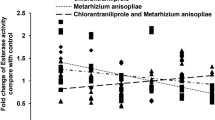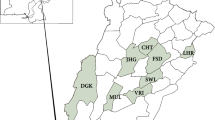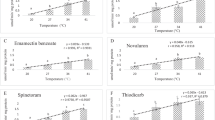Abstract
The cotton leafworm, Spodoptera littoralis Boisaduval (Lepidoptera: Noctuidae), is an invasive species causing serious damage in crop production and is commonly controlled for seven decades with the organophosphorus (OP) compounds. Despite their low effectiveness, about 90 of these compounds are still in use and play a major role in pest control. The sensitivity of acetylcholinesterase (AchE) to chlorpyrifos was compared in susceptible strain (LS) and resistant strain (FR) of S. littoralis. The FR was significantly resistant to chlorpyrifos (70.64-fold) compared to LS strain. Inhibition studies revealed apparent differences in sensitivity of AchE enzyme from resistant and susceptible larvae to chlorpyrifos. In comparison to AchE from LS, the enzyme of insect’s resistant to chlorpyrifos has Michaelis–Menten constant (Km) and maximum velocity (Vmax) values1.98- and 2.54-times higher. Overall, the current study supports the importance of AchE-altered in created resistance to OP compounds.
Similar content being viewed by others
Avoid common mistakes on your manuscript.
Introduction
The cotton leafworm, Spodoptera littoralis Boisaduval (Lepidoptera: Noctuidae), is a worldwide economically important key pest. The immature stages of S. littoralis are commonly controlled with the application of synthetic insecticides. However, the indiscriminate use of these insecticides can cause the development of resistant populations (Ismail et al. 2020; Hilliou et al. 2021). Since the mid-1950s, widespread use of OP compounds as insecticides around the world is one of the main reasons for the outbreaks of pests (Fournier 2005). Despite OP compounds have become largely ineffective, they still play a major role in pest control. So urgent action is required to manage the resistance and expand the lifespan of these compounds (Hilliou et al. 2021). Carbamate and OP compounds are potent AchE (EC3.1.1.7), inhibitors which blocks the enzyme activity via a reversible complex formation followed by phosphorylation or carbamylation of AchE (Dawkar et al. 2013; Umar and Aisami 2020). AchE hydrolyzes the neurotransmitter acetylcholine (Ach) to terminate neuronal excitement at the postsynaptic membrane (Mwila et al. 2013). Decrease in sensitivity of the target enzyme, AchE, to OPs has as well been reported in more than 30 insecticide resistant pest species (Mutero et al. 1994; Afzal et al. 2015; Moradi et al. 2019). Knowledge of AchE kinetics is a prerequisite for understanding the effects of mutation in resistant insects. However, studies concerning the biochemical basis of pest resistance to insecticides are scarce. The present study focused on the possible involvement of AchE in conferring resistance in OP-resistant insect populations. Therefore, the sensitivity of AchE to chlorpyrifos was compared through the kinetic parameters of AchE in the two strains of S. littoralis. This study will help in resistance management by understanding and overcoming resistance problems.
Materials and Methods
Insects
The originally FR strain of the cotton leafworm, Spodoptera littoralis Boisaduval (Lepidoptera: Noctuidae) was collected from the cotton fields of Biala district, Kafr El-Sheikh Governorate, Egypt. These populations have been exposed to frequent use of various insecticides including OP insecticides in these fields. The collected S. littoralis egg mass was carefully transferred to the laboratory. A reference susceptible strain LS of S. littoralis was obtained from Department of Insect Population Toxicology, Central Agricultural Pesticides Laboratory, Agriculture Research Center, Giza, Egypt, and a laboratory population has been maintained in the rearing chamber without exposure to any insecticide for over 15 years. Two strains were reared on castor bean leaves (Ricinus communis L.) and maintained in the rearing chamber under controlled conditions of 25 ± 1 °C, 65 ± 5% relative humidity, and a photoperiod of 16:8 (h light: dark).
Insecticide and Chemicals
The OP insecticide chlorpyrifos (O,O-diethyl-O-3,5,6-trichloro-2-pyridyl phosphorothioate, purity 99.5%) was purchased from Chem. Service (West Chester, PA). Bovine serum albumin (BSA) protein assay standard was purchased from Bio-Rad Laboratories (Hercules, CA). 5,5′-dithio-bis(2-nitrobenzoic acid) (DTNB), and Pyridostigmine bromide were purchased from Sigma Chemical (St. Louis, MO).
Toxicity Bioassay
The toxicity of the chlorpyrifos to 3rd instar larvae (< 12 h) of S. littoralis was evaluated in two strains through topical application. Larvae were treated on the dorsum with 2 μL of each concentration of insecticide solution or acetone (control). Three replicates (n = 10 larvae per replicate) for each concentration as well as the control. Larvae were moved to a glass jar for 24 h, then mortality was noted. If larvae were not able to move in a coordinated way when gently stimulated with a fine brush, the larvae were considered as dead. The jars were placed in the rearing chamber at 25 ± 1 °C, 65 ± 5% relative humidity and 16:8 L:D. The dose of insecticide that was lethal to 50% of tested larvae (LD50) was calculated using probit analysis using the SPSS program (SPSS Inc., Chicago, IL).
Sample Preparation and Enzyme Assays
The larvae alive after treatment with chlorpyrifos of two strains were homogenized in 200 μL phosphate buffer pH (7.0). The homogenates were centrifuged at 4 °C, 10,000 rpm for 10 min. The supernatants were used as the enzyme source. AchE activity was determined according to colorimetric method of Ellman et al. (1961) using ATChI as substrate. Fifty μL of supernatant was added to a tube containing 140 μL of phosphate buffer (0.1 M, pH 7), 50 μL substrate (ATChI, 75 mM), and 20 μL DTNB (0.1 M). After 15 min of incubating the reaction mixture at room temperature, 0.5 mL of pyridostigmine bromide (1 mM) was added to stop the reaction. Level of enzyme activity was measured at 412 nm using a spectrophotometer (Shimatzu UV-1600®) at 412 nm. AchE activity was expressed as units per mg of protein after measurement of protein by Bradford (1976) method, using BSA as a standard.
Assays of Activity, Kinetics, and Sensitivity of AchE
Kinetic parameters of AchE were determined based on the AchE activity at two substrate concentrations (1 and 10 mM) as previously descried in the assay of AchE activity. The enzyme kinetic parameters, Michaelis–Menten constant (Km) and maximum velocity (Vmax) were estimated using Lineweaver–Burk plot (Lineweaver and Burk 1934). Estimation of I50 value (the inhibitor concentration required to inhibit 50% of the enzyme activity) was done by pre-incubating the AchE solution in different concentrations (0.01–2 μM) of chlorpyrifos for 10 min. Afterward, the substrate was added to the reaction mixture containing phosphate buffer (pH 7.0), and DTNB. Also, the inhibitory constant (Ki) was determined according to the method of Dixon and Webb (1964).
Statistical Analysis
The data obtained from the toxicity test were corrected using Abbott’s formula (1925) before analysis, and data were subjected to probit. RR = LD50 FR/LD50 LS. All tests and control (without chlorpyrifos) assays were corrected by blanks for non-enzymic hydrolysis. Assays were performed in triplicate. According to the Lineweaver–Burk plot and Dixon-plot, it was estimated how chlorpyrifos inhibited AchE. The mean values of the recorded data were subjected to analysis of variance (ANOVA), followed by Tukey’s test at P < 0.05 significant level using SAS program (SAS Institute, 2004).
Results
Resistance Level
The LS and the FR strains of Spodoptera littoralis showed significant difference in toxicity to chlorpyriphos; LD50 value of LS strain = 4.07 µg/larva, χ2 = 0.39, df = 2, P = 0.96; LD50 value of FR strain = 287.49 µg/larva, χ2 = 6.54, df = 2, P = 0.62.
In Vitro AchE Inhibition
The in vitro inhibitory effect of chlorpyrifos on AchE in both LS and FR strains at 0.1 and 0.05 µM showed high inhibitory activity in LS strain and there was significant difference between the two concentrations (91.67% and 76.81% at 0.1 and 0.05 µM, respectively). In contrast, the effect of chlorpyrifos was low on AchE in the FR strain at two concentrations (29.34% and 14.66% at 0.1 and 0.05 μM, respectively) (Fig. 1).
Sensitivity of AchE
Table 1 provides inhibition constants determined from the inhibition reaction of chlorpyrifos on AchE from the two strains. Significant differences were observed in I50 and ki values between the two strains. The I50 and ki values of AchE from FR strain were 5.22- and 1.24-fold, respectively, less sensitive to inhibition by chlorpyrifos than LS strain.
Kinetics of AchE
A comparison of the AchE sensitivity and resistance in the two strains showed the Vmax and Km values for AchE in the FR strain decreased by 2.54- and 1.98-fold, respectively (Table 2).
Discussion
Based on the results, FR strain showed a high rate of resistance to chlorpyrifos 70.64-fold compared to the LS strain. Previous studies demonstrated that resistance to OP insecticides has developed in many insects such as Bemisia tabaci (Gennadius) (Zhang et al. 2012), Phenacoccus solenopsis (Tinsley) (Afzal et al. 2015), Drosophila melanogaster (Meigen) (Daisley et al. 2018) and Spodoptera littoralis (Boisaduval) (Ismail 2020).
In this study, the results indicated that the I50 and ki values of AchE in the FR strain are about 5.22- and 1.24-fold, respectively, higher than in the LS strain and this resistance is attributable to the modification of AchE enzyme to an insensitive form (Houndété et al. 2010; Afzal et al. 2015; Moradi et al. 2019; Ismail 2021). All findings in other studies have shown that AchE insensitivity to OP insecticides plays an important role in the differences of susceptibility in several insects, including Cydia pomonella (Linnaeus) (Reyes et al. 2007), Helicoverpa armigera (Hübner) (Farnsworth et al. 2010), Laodelphax striatellus (Fallén) (Xu et al. 2014) and Spodoptera littoralis (Boisaduval) (Ismail 2020).
Kinetic analyses clearly showed that the Km and Vmax values of AchE in the FR strain are about twofold less compared to those from the LS strain. Alteration in Km and Vmax values between FR and LS strains may affect AchE sensitivity for various organophosphorus based insecticides. Various studies show that higher Km and Vmax activities are indicators of resistance (Gao et al. 1998; Ismail 2008; Lang et al. 2010; Hwang et al. 2014). In general, all the results showed that the decreased sensitivity to AchE, played an important role in increasing the OP resistance.
Conclusion
Overall, these results support a direct causal relationship between the insensitivity of AchE and resistance to OP insecticides. Therefore, rotation of OP insecticides with insecticides of other classes in application schedule against insect pests may slow the development of resistance from OP insecticides.
Availability of Data and Material
All data generated or analyzed during this study are included in this published article.
Abbreviations
- AchE:
-
Acetylcholinesterase
- FR:
-
Resistant strain
- LS:
-
Susceptible strain
- OP:
-
Organophosphorus compounds
- RR:
-
Resistance ratio
References
Abbott, W. 1925. A method of computing the effectiveness of an insecticide. Journal of Economic Entomology 18(2): 265–267. https://doi.org/10.1093/jee/18.2.265a.
Afzal, M.B.S., M. Ijaz, Z. Farooq, S.A. Shad, and N. Abbas. 2015. Genetics and preliminary mechanism of chlorpyrifos resistance in Phenacoccus solenopsis Tinsley (Homoptera: Pseudococcidae). Pesticide Biochemistry and Physiology 119: 42–47. https://doi.org/10.1016/j.pestbp.2015.02.008.
Bradford, M.M. 1976. A rapid and sensitive method for the quantification of microgram quantities of protein utilizing the principle of protein-dye binding. Analytical Biochemistry 72: 248–254. https://doi.org/10.1006/abio.1976.9999.
Daisley, B.A., M. Trinder, T.W. McDowell, S.L. Collins, M.W. Sumarah, and G. Reid. 2018. Microbiota-mediated modulation of organophosphate insecticide toxicity by species-dependent interactions with lactobacilli in a Drosophila melanogaster insect model. Applied and Environmental Microbiology 84(9): e02820–e2917. https://doi.org/10.1128/AEM.02820-17.
Dawkar, V.V., Y.R. Chikate, P.R. Lomate, B.B. Dholakia, V.S. Gupta, and A.P. Giri. 2013. Molecular insights into resistance mechanisms of lepidopteran insect pests against toxicants. Journal of Proteome Research 12: 4727–4737. https://doi.org/10.1021/pr400642p.
Dixon, M., and E.C. Weeb. 1964. Enzymes, 2nd ed., 328–330. New York: Academic Press Inc.
Ellman, G.L., K.D. Courtney, V. Andres, and R.M. Featherstone. 1961. A new and rapid colorimetric determination of acetylcholinesterase activity. Biochemical Pharmacology 7: 88–95. https://doi.org/10.1016/0006-2952(61)90145-9.
Farnsworth, C.A., M. Teese, G. Yuan, Y. Li, C. Scott, X. Zhang, et al. 2010. Esterase-based metabolic resistance to insecticides in heliothine and spodopteran pests. Journal of Pesticide Science 35(3): 275–289. https://doi.org/10.1584/jpestics.R10-13.
Fournier, D. 2005. Mutations of acetylcholinesterase which confer insecticide resistance in insect populations. Chemico-Biological Interactions 157: 257–261. https://doi.org/10.1016/j.cbi.2005.10.040.
Gao, J.R., J.V. Rao, G.E. Wilde, and K.Y. Zhu. 1998. Purification and kinetic analysis of acetylcholinesterase from western corn rootworm, Diabrotica virgifera (Coleoptera: Chrysomelidae). Insect Biochemistry and Physiology 39(3): 118–125. https://doi.org/10.1002/(SICI)1520-6327(1998)39:3%3c118::AID-ARCH4%3e3.0.CO;2-6.
Hilliou, F., T. Chertemps, M. Maïbèche, and G.L. Goff. 2021. Resistance in the genus Spodoptera: Key insect detoxification genes. Insects 12(6): 544. https://doi.org/10.3390/insects12060544.
Houndt, T.A., D. Fournier, G.K. Ketoh, I.A. Glitho, R. Nauen, and T. Martin. 2010. Biochemical determination of acetylcholinesterase genotypes conferring resistance to the organophosphate insecticide chlorpyriphos in field populations of Bemisia tabaci from Benin, West Africa. Pesticide Biochemistry and Physiology 98: 115–120. https://doi.org/10.1016/j.pestbp.2010.05.009.
Hwang, C.E., Y.H. Kim, D.H. Kwon, K.M. Seong, J.Y. Choi, H.Y. Je, and S.H. Lee. 2014. Biochemical and toxicological properties of two acetylcholinesterases from the common bed bug, Cimex lectularius. Pesticide Biochemistry and Physiology 110: 20–26. https://doi.org/10.1016/j.pestbp.2014.02.002.
Ismail, S.M. 2008. Biochemical studies of Na+, K+-ATPase and acetylcholinesterase sensitivity to phenothrin and thiodicarb among different field populations of Spodoptera littoralis. Alexandria Science Exchange Journal 29(1): 26–35. https://doi.org/10.21608/asejaiqjsae.2008.3179.
Ismail, S.M. 2020. Joint toxic action of spinosad with fenpropathrin and chlorpyrifos and its latent effect on different Egyptian field populations of Spodoptera littoralis. Asian Journal of Biological Sciences 13(4): 2–7. https://doi.org/10.3923/ajbs.2020.XX.XX.
Ismail, S.M. 2021. Cholinesterase and aliesterase as a natural enzymatic defense against chlorpyrifos in field populations of Spodoptera littoralis (Boisduval, 1833) (Lepidoptera, Noctuidae). Journal of Plant Bioinformatics and Biotechnology 1(1): 41–50. https://doi.org/10.22034/ipbb.2021.288332.1007.
Ismail, S.M., F.A. Abdel-Galil, SSh. Hafez, and U.M. AbuEl-Ghiet. 2020. Influence of some insecticides on the incidence of common Lepidopterous insect pests in field cotton. Egyptian Academic Journal of Biological Sciences, F Toxicol Pest Control 12(1): 23–30. https://doi.org/10.21608/eajbsf.2020.73377.
Lang, G.J., X.H. Zhang, M.Y. Zhang, and C.X. Zhang. 2010. Comparison of catalytic properties and inhibition kinetics of two acetylcholinesterases from a lepidopteran insect. Pesticide Biochemistry and Physiology 98(2): 175–182. https://doi.org/10.1016/j.pestbp.2010.06.003.
Lineweaver, H., and D. Burk. 1934. The determination of enzyme dissociation constants. Journal of the American Chemical Society 56(3): 658–666. https://doi.org/10.1021/ja01318a036.
Moradi, S., S. Khani, M. Ansari, and M. Shahlaei. 2019. Atomistic details on the mechanism of organophosphates resistance in insects: Insights from homology modeling, docking and molecular dynamic simulation. Journal of Molecular Liquids 276: 59–66. https://doi.org/10.1016/j.molliq.2018.11.152.
Mutero, A., M. Pralavorio, J.M. Bride, and D. Fournier. 1994. Resistance-associated point mutations in insecticide-insensitive acetylcholinesterase. Proceedings of the National Academy of Sciences 91(13): 5922–5926. https://doi.org/10.1073/pnas.91.13.5922.
Mwila, K., M. Burton, J. Van Dyk, and B. Pletschke. 2013. The effect of mixtures of organophosphate and carbamate pesticides on acetylcholinesterase and application of chemometrics to identify pesticides in mixtures. Environmental Monitoring and Assessment 185: 2315–2327. https://doi.org/10.1007/s10661-012-2711-0.
Reyes, M., P. Franck, P.J. Charmillot, C. Ioriatti, J. Olivares, E. Pasqualini, and B. Sauphano. 2007. Diversity of insecticide resistance mechanisms and spectrum in European populations of the Codling moth, Cydia pomonella. Pest Management Science 63(9): 890–902. https://doi.org/10.1002/ps.1421.
Umar, A.M., and A. Aisami. 2020. Acetylcholinesterase enzyme (AChE) as a biosensor and biomarker for pesticides: A mini review. Bulletin of Environmental Science and Sustainable Management 4(1): 7–12. https://doi.org/10.54987/bessm.v4i1.526.
Xu, L., M. Wu, and Z. Han. 2014. Biochemical and molecular characterization and cross-resistance in field and laboratory chlorpyrifos-resistant strains of Laodelphax striatellus (Hemiptera: Delphacidae) from eastern China. Pest Management Science 70 (7): 1118–1129. https://doi.org/10.1002/ps.3657.
Zhang, N.N., C.F. Liu, F. Yang, S.H. Dong, and J.H. Zhao. 2012. Resistance mechanisms to chlorpyrifos and F392W mutation frequencies in the acetylcholine esterase ace1 allele of field populations of the tobacco whitefly, Bemisia tabaci in China. Journal of Insect Science 12(1): 41. https://doi.org/10.1673/031.012.4101.
Acknowledgements
I would like to express my gratitude to the editor and the reviewers for their valuable comments during the review of this study.
Funding
No funds, grants, or other support was received.
Author information
Authors and Affiliations
Contributions
S.M.I. subject selection, study design, carried out the experiments, paper writing, collecting, interpretation of the data, and performing statistical analysis. The author read and approved the final manuscript.
Corresponding author
Ethics declarations
Conflict of interest
The authors declare that they have no conflict of interests.
Ethics Approval and Consent to Participate
Not applicable.
Consent for Publication
Not applicable.
Additional information
Publisher's Note
Springer Nature remains neutral with regard to jurisdictional claims in published maps and institutional affiliations.
Rights and permissions
Springer Nature or its licensor (e.g. a society or other partner) holds exclusive rights to this article under a publishing agreement with the author(s) or other rightsholder(s); author self-archiving of the accepted manuscript version of this article is solely governed by the terms of such publishing agreement and applicable law.
About this article
Cite this article
Ismail, S.M. Laboratory Evaluation of Chlorpyrifos Against Resistant and Susceptible Strains of a Moth Pest of Crop Plants, Spodoptera littoralis (Lepidoptera: Noctuidae). Proc Zool Soc 76, 1–5 (2023). https://doi.org/10.1007/s12595-022-00461-2
Received:
Revised:
Accepted:
Published:
Issue Date:
DOI: https://doi.org/10.1007/s12595-022-00461-2





